|
 Secure Site
Secure Site
|
 |
Archive for the 'Meditation Timers' Category
 creating a meditation space in your home • It doesn’t really matter where your meditation space is located in your house, although Rodney Yee says the Balinese consider the northeast corner culturally and religiously auspicious. Tias Little likes the southeast corner because it captures morning light for early meditation. Basically, says Yee, pick a space where you feel relaxed and comfortable. “I think everybody has a special little place where they go to be quiet—just like a cat that searches until it finds the right spot to sleep.”
• You can think big thoughts in any size space. Your meditation area can be as expansive as Richard Freeman’s, a room “at the very top of the house, encompassed by a big maple tree,” or simply a spare closet or an empty corner. Rainbeau Mars likes a window for fresh air as long as it’s not distracting, but Little says a semi-enclosed space can give a “really spectacular feeling, like a little womb.” You might consider creating a six- or seven-foot-square adobe “cell” addition to your house or yard.
 meditation space • “Anyone can use [a meditation space], but only for meditation,” Deepak Chopra says. Freeman says to minimize distraction, you should choose a location that’s as isolated as possible from the traffic flow in your house, and it shouldn’t be in an area where you’re more tempted to sleep than meditate. If you share your space, each person should have his or her own chair, cushion, zabuton mat, or zafu pillow, “something that sanctifies this is my space,” Mars says. Sit on it only when you meditate. That helps create a ritual conducive to meditation, Judith Hanson Lasater says. It is nice to have a special Zen Meditation Timer on a table beside your the chair or cushion that you meditate on. This way you can easily reach the meditation timer to turn it off when it chimes and then you can continue to sit in peace until ready to move.
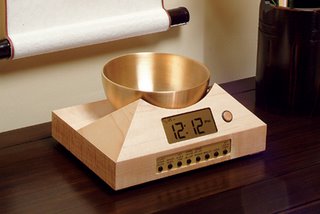 Zen Timepiece, a brass singing bowl clock and timer • Tatami mats or bare wood floors are a better, cleaner option than rugs or carpets, and they create a more spacious feeling, Little says.
• An altar is a good idea. “When you set it up, the space begins to get that special feeling,” Yee says. An altar makes it clear the space is reserved for meditation and serves as a repository for your sacred objects and decorations. It needn’t be elaborate: Little has seen window sills used as altars. Yee’s altar is a small, low table covered with a Balinese cloth; Freeman’s is a stone slab.
• If you do yoga in your meditation space, store props such as mats, blocks, and straps in a chest. Leaving them out creates distracting clutter.
• Avoid bright overhead lighting, or use a dimmer switch. Lamps or sconces are best because they combine illumination with warmth.
• Include a timer. Meditation is all about discipline and consistency, and meditating a set amount of time each day can help achieve that, Lasater says. The Zen Timepiece chimes gently at the end of one’s meditation without startling one back to the here and now.
 Bamboo Zen Meditation Timer • Even experts disagree on how to decorate your space. Most are minimalists. “It needs to be elegant in its simplicity and with very little clutter,” Chopra says. His recommended decorations include candles, books, and symbolic representations of archetypal figures such as gods, goddesses, angels, flowers, incense, and pastel colors. “You should not include anything that symbolically represents violence,” he adds. Yet not everyone finds minimalism calming, points out Freeman. “Some people display every saint they’ve ever heard of; some people may have only one. Others might light a candle; others prefer nothing. It’s whatever makes you want to sit there and do nothing.”
adapted from Natural Home Magazine, Jan/Feb 2005 by Vicky Uhland
Posted in Bamboo Chime Clocks, Japanese Inspired Zen Clocks, Meditation Timers, Meditation Tools, mindfulness practice, Well-being, Zen Timers
 Use our unique "Zen Clock" which functions as a Yoga & Meditation Timer Nearly half the time we’re awake, our thoughts drift to topics unrelated to whatever we’re doing, U.S. News reports. We think about a fight with our spouse when we’re driving, or replay events from a friend’s wild party while brushing our teeth in the morning. We text incessantly while watching TV, and phone mom during laundry-folding time. And while our minds wander—even when we’re having pleasant daydreams—we’re not very happy, according to a study published last year in the journal Science. “How often peoples’ minds wander is definitely a big predictor of who’s happy and who’s not happy,” says study author Matthew Killingsworth, a doctoral candidate in psychology at Harvard University, because the more often they take themselves out of the present moment, the less happy they are.
The study found that happiness falls when folks aren’t focused on the task at hand, even an unenjoyable one, like doing errands. The researchers used a novel approach to get real-time snapshots of what the 2,250 study participants were thinking and how they felt throughout the day. They developed a free iPhone app that buzzed volunteers, whose average age was 34, several times a day asking them how they were feeling right before they were contacted, what they were doing and whether they were thinking about something other than what they were doing. Except during sex, participants recorded their minds wandering during every activity; most frequently, minds drifted off during personal grooming like taking a shower, shaving, and putting on makeup.
 Our Yoga Timer & Clock can be programmed to chime at the end of the meditation or yoga session or periodically throughout the session as a kind of sonic yantra Use our unique “Zen Clock” which functions as a Yoga & Meditation Timer. It features a long-resonating acoustic chime that brings your meditation or yoga session to a gradual close, preserving the environment of stillness while also acting as an effective time signal. Our Yoga Timer & Clock can be programmed to chime at the end of the meditation or yoga session or periodically throughout the session as a kind of sonic yantra. The beauty and functionality of the Zen Clock/Timer makes it a meditation tool that can actually help you “make time” for meditation in your life. Bring yourself back to balance.
By ANGELA HAUPT from US News
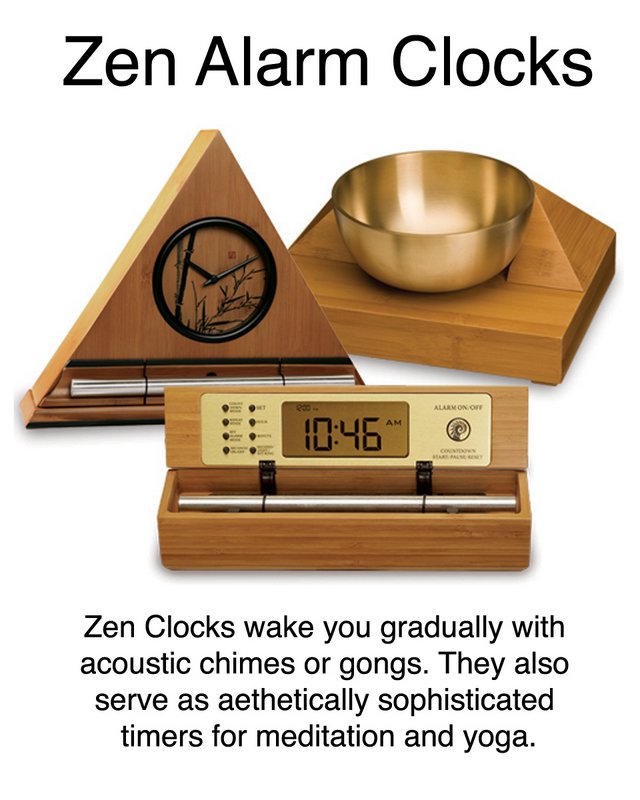 The beauty and functionality of the Zen Clock/Timer makes it a meditation tool that can actually help you "make time" for meditation in your life. Bring yourself back to balance. Now & Zen – The Singing Bowl Meditation Timer Store
1638 Pearl Street
Boulder, CO 80302
(800) 779-6383
Posted in Meditation Timers
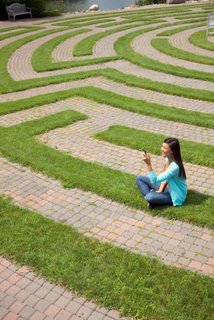 Walking Meditation As my colleague Rusty wrote last week, youshouldn’t get mad at work. But sometimes it just happens. One minute you’re typing up a memo, and the next, you realize it’s been a good minute since you took a breath. Anger has a devilish way of sneaking up on us—especially at work.
But here’s a cure: walking meditation.
At the onset of anger, the best thing you can do for yourself and your career is get up from your desk and walk away. Implement these steps for a successful walking meditation session, and your quality of life at work will dramatically improve.
The goal is to observe the act of walking while becoming completely aware of your body, your breathing, and your surroundings.
Step One: Schedule walking meditation practice on a daily basis. As with most things in life, practice makes perfect. One of the keys to maintaining equanimity is to incorporate regular meditation into your daily life. By scheduling a daily walk, you will improve your meditation skills, ensure you get up from your desk, and create a routine, which gives you a better shot at achieving success. By practicing regularly, you’ll learn to squash anger quickly when it arises.
Step Two: Choose a walking meditation route. One of the goals of this practice is to quiet our minds. We all spend much of our day multitasking at work, while juggling our personal lives as well. Choose a route with little vehicular or pedestrian traffic. The ideal route will be straight, flat, and outdoors. However, walking meditation can be practiced anywhere; a stairwell, quadrangle, or even the office lobby. Try several different routes until you find one that works for you. The best routes are ones that give you enough to observe, without over-stimulating your mind.
Step Three: Before you get started, take several deep breaths. Stand still. Take air in through your nose and feel your abdomen rise. Make yourself aware of the earth under your feet. Enjoy the miracle of being alive. Forget whatever brought you to get up from your desk and temporarily walk away. Tell yourself that you are about to take a walk and clear your mind because you deserve to feel good—even at work.
Step Four: You are now ready to begin your walk. Take measured steps and get in tune with your body. Notice how your feet feel against the ground, how your legs are gliding you forward, how the air feels against your face. Remember that this is not a race. You are enjoying this walk and the world will be fine even if you check out for a few minutes.
 Walking Meditation Step Five: Keep your mind quiet. As you walk, thoughts will pop into your head. Some of them will be negative thoughts about work. Others might be about how you have 1,000 things to do when you get home tonight. As each thought comes up, acknowledge it, let it go, and concentrate on the walk. This walk is to clear your mind—not clutter it. It is important not to become angry with yourself if this task is difficult for you. Most people are surprised about how difficult it is to shut off their brains for a few minutes! With some practice, it will become easier for you to quiet your mind.
Step Six: Wind down. Ideally you’ll be able to devote 15 minutes a day at work to your walking meditation practice. However, not everyone has that luxury at work. With some practice, a successful walking meditation session can be as short as the walk from your desk to the bathroom. Remember, the goal is to regain your balance and not allow yourself to get angry, upset, or overly emotional at work. Also, don’t end your walking meditation abruptly. Ease yourself back into work life by coming to a planned halt.
Step Seven: Use a mental checklist. When your walk ends, notice how your body feels compared to the beginning of the walk. The good news is that you can’t fail at meditation; there are only varying degrees of success. Don’t have any expectations, other than you know this exercise is good for your body and mind—even if the results aren’t obvious.
Walking meditation has done wonders for my mental clarity at work, and I hope it helps you too! There are many different approaches to this practice. Let us know what works best for you.
Our Zen Timepiece’s acoustic 6-inch brass bowl-gong clock is the world’s ultimate alarm clock, practice timer, and “mindfulness bell.”
It fills your environment with beautifully complex tones whenever it strikes. In the morning, its exquisite sounds summon your consciousness into awakening with a series of subtle gongs that provide an elegant beginning to your day. Once you experience the Zen Timepiece’s progressive awakening, you’ll never want to wake up any other way. It also serves as the perfect meditation timer. Available in 5 wood styles, including bamboo (shown).
It’s exquisite sounds summon your consciousness out of your meditative state with a series of subtle gongs. Once you experience the Zen Timepiece’s progressive tones, you’ll never want to meditate any other way. It serves as the perfect meditation timer. Available in 5 wood styles, including bamboo.
Andrew G. Rosen is the founder and editor of Jobacle.com, a career advice blog. He is also the author of How to Quit Your Job.
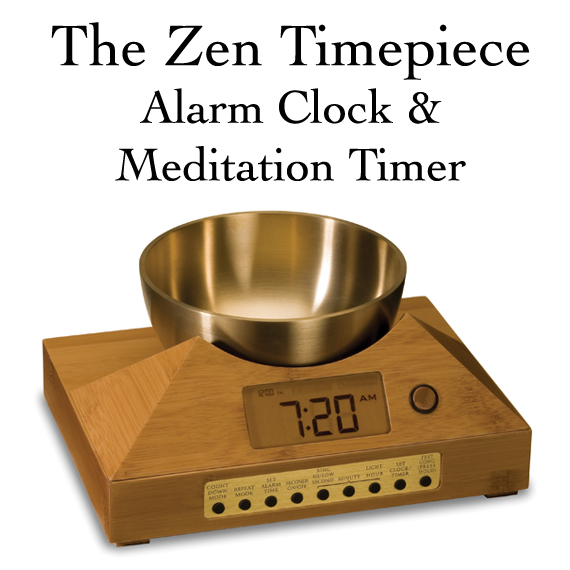 Use our unique "Zen Clock" which functions as a Yoga & Meditation Timer Now & Zen – The Singing Bowl Meditation Timer Store
1638 Pearl Street
Boulder, CO 80302
(800) 779-6383
orders@now-zen.com
Posted in Meditation Timers
 Try a Listen Meditation as a Mindfulness Practice Listening Meditation
Instructor Sally Kempton is a spiritual guide who teaches yoga and meditation at her Carmel, Calif.-based Awakened Heart Meditation (sallykempton.com). She authored The Heart of Meditation under her monastic name Swami Durgananda.
What is it? While many meditation techniques require solitude and silence, this one has you engage with the sounds all around you; it invites you to work with and use the noise instead of fighting it. Listening meditation also encourages you to harmonize with your surroundings, and, by extension, the universe. The intent is to experience sound as vibration, rather than information. The listening practice is a way of interacting with the environment that allows you to take in the whole energy of the present moment, says Kempton.
What’s it good for? Especially adaptable and portable, listening meditation can be practiced in crowded, noisy situationson a bus, at the office that would be hard on other styles. (Kempton once led a listening meditation workshop in the middle of a busy Whole Foods store!) People with particularly chattering minds may need to couple this practice with a mantra or breathing meditation. However, many people welcome the chance to focus outward rather than inward and find that listening meditation is one of the easier techniques to undertake. You’ll come away from it feeling refreshed, expanded, and at ease with your environment, declares Kempton.
How long does it take? Try for five minutes at first, then add a minute or two until you can do it for 15 or 20 minutes at a time. Set your Chime Meditation Timer by Now & Zen for five minutes and then increase as you get better at this practice.
How Do I Do It?
1. Set your Meditation Chime Timer for 5 minutes (increase the minutes as you improve). Sit in a comfortable position and close (or half close) your eyes.
2. To get centered and quiet the mind, first bring your awareness to your breath, noticing but not trying to change it.
3. Now open your ears and bring your awareness to the sounds around you. The goal is to listen to the whole range of sounds, without favoring one over another and without identifying them. Hear the quiet sounds and the silences as well as the dominant sounds.
4. When you find yourself identifying sounds (there’s a fire engine; thats the cat scratching the rug), gently redirect your attention from listening to a specific noise back to hearing the whole spectrum of sounds.
5. To end, slowly open your eyes, stand, and carry this heightened awareness with you for as long as you can.
Tip: Do a one-minute mini-listening meditation while standing in line or sitting at your desk, or anytime you feel frazzled: Close your eyes, breathe, and listen to the sounds around you. Like the practice of counting to 10 when you’re in the heat of an argument, this will help you pause, center, and regroup.
 Zen Meditation Timers, The Digital Zen Alarm Clock in Solid Walnut adapted from Natural Health Magazine
Now & Zen’s Chime Time Store
1638 Pearl Street
Boulder, CO 80302
(800) 779-6383
Posted in Bamboo Chime Clocks, Chime Alarm Clocks, intention, Meditation Timers, Meditation Tools, mindfulness practice, Well-being, Zen Timers
 Once you experience the Zen Timepiece's progressive tones, you'll never want to meditate any other way. UTAMARO, Kitagawa, A Mother Dozing While Her Child Topples a Fish Bowl Pay close attention to each feeling, and let it be
Let’s say you slam into the back of a car that cuts you off or your boss moves your deadline up a week. How do you react? Perhaps your pulse quickens as you berate yourself for not foreseeing the circumstance. Maybe your breathing shortens as you feel anger or panic—or both. Most people, though, don’t notice such details; they react with an “Aargh!” and distract themselves with a run or a beer or a gallon of ice cream.
But researchers say one of the best ways of soothing stress is to be “mindful,” to pause and actually tune in to what’s going on at the moment. Being acutely aware of what you’re experiencing—the racing heart, the tumbling thoughts—and accepting it without judgment, observing as it changes, has a strong calming effect, experts say. “You might have a thought like ‘I’m a failure,’ but you know that it’s just a thought,” explains researcher Elissa Epel, an associate professor of psychiatry at the University of California-San Francisco School of Medicine. That will prevent you from turning those thoughts into a self-fulfilling prophecy by, say, quitting the gym or a challenging job.
Wandering thoughts. How do you get to a mindful state in the midst of a panic? Most people need to practice a form of meditation that focuses on their breathing and sensations in each body part. If your mind wanders (and it will), you just acknowledge the errant thoughts, let them go, and bring your attention back to the breath. Check out a mindfulness tape at mindfulnesstapes.com, or take a free virtual-mindfulness class on YouTube with Jon Kabat-Zinn, a professor of medicine emeritus at the University of Massachusetts and author of several books on mindfulness. “You are training your mind to be less reactive and more stable,” he writes in Full Catastrophe Living. A 2007 study found that mindfulness classes gave students an improved sense of well-being—and that practicing the technique for about 30 minutes a day helped induce a mindful response when people would normally feel stress.
 It's exquisite sounds summon your consciousness out of your meditative state with a series of subtle gongs. The practice may also help alleviate some of the physiological damage caused by chronic stress, like the tendency to store fat around abdominal organs. Epel and her colleagues are currently studying whether 50 overweight women who describe themselves as “stress eaters” can curb food cravings by practicing mindfulness—by noticing a raisin’s color, texture, and smell, say, before eating it. If stress reduction practices lower cortisol levels, the body’s storage of fat should shift from the abdomen to the hips and thighs, where it won’t cause insulin resistance, Epel speculates. A bonus: It might get easier to stop at one Oreo.
By DEBORAH KOTZ for US News
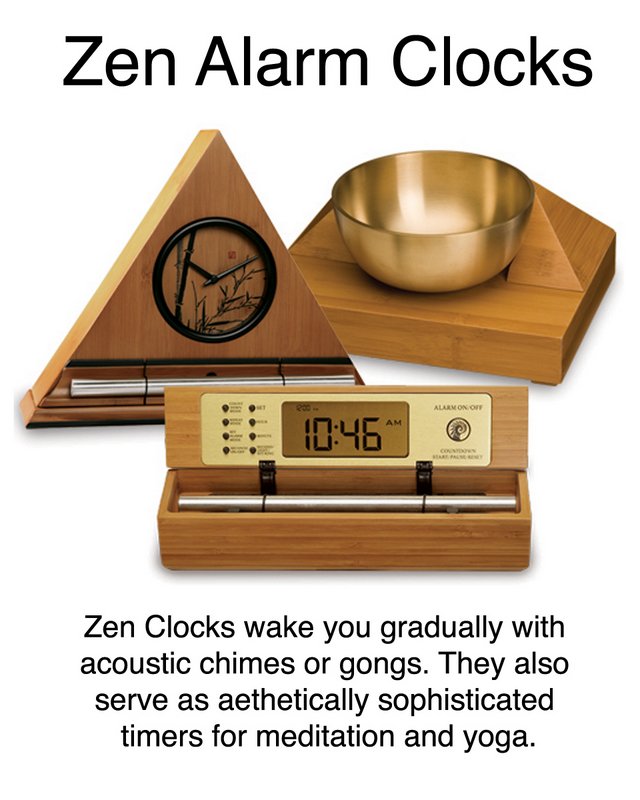 It's exquisite sounds summon your consciousness out of your meditative state with a series of subtle gongs.
Posted in Meditation Timers, Meditation Tools
 It's exquisite sounds summon your consciousness out of your meditative state with a series of subtle gongs. ‘Om’ is where the heart is:
Meditation is gaining attention as a potential way to maintain well-being and good health. It can calm your mind, relax your body, and soothe your spirit. In addition, it’s inexpensive and its risks are minimal.
Meditation techniques aren’t new. They’ve been around for thousands of years. Anyone can meditate, regardless of religious or cultural background.
Consider these suggestions from the Mayo Clinic to get you started :
- Select a meditation technique that fits your lifestyle and belief system. Many people build meditation into their daily routine.
- Set aside some time. Start with 5-minute meditation sessions once or twice a day and work up to 20 minutes each time.
- Keep trying. Be kind to yourself as you get started. If you’re meditating and your attention wanders, slowly return to the object, sensation or movement you’re focusing on.
- Make meditation part of your life. Many people prefer to start and end their day with a period of meditation. Others prefer to take meditation breaks during the day. Experiment and find out what works best for you.
— Nancyann Rella
Meditation is generally an inwardly oriented, personal practice, which individuals do by themselves. Meditation may involve invoking or cultivating a feeling or internal state, such as compassion, or attending to a specific focal point. The term can refer to the state itself, as well as to practices or techniques employed to cultivate the state. There are dozens of specific styles of meditation practice; the word meditation may carry different meanings in different contexts. Meditation has been practiced since antiquity as a component of numerous religious traditions. A 2007 study by the U.S. government found that nearly 9.4% of U.S. adults (over 20 million) had practiced meditation within the past 12 months, up from 7.6% (more than 15 million people) in 2002.
 Once you experience the Zen Timepiece's progressive tones, you'll never want to meditate any other way. It serves as the perfect meditation timer.
Although meditation can be done in almost any context, practitioners usually employ a quiet, tranquil space, a meditation cushion or bench, and some kind of timing device to time the meditation session. Ideally, the more these accoutrements can be integrated the better. Thus, it is conducive to a satisfying meditation practice to have a timer or clock that is tranquil and beautiful. Using a kitchen timer or beeper watch is less than ideal. And it was with these considerations in mind that we designed our digital Zen Alarm Clock and practice timer. This unique “Zen Clock” features a long-resonating acoustic chime that brings the meditation session to a gradual close, preserving the environment of stillness while also acting as an effective time signal. The Digital Zen Clock can be programmed to chime at the end of the meditation session or periodically throughout the session as a kind of sonic yantra. The beauty and functionality of the Zen Clock/Timer makes it a meditation tool that can actually help you “make time” for meditation in your life.
 Once you experience the Zen Timepiece's progressive tones, you'll never want to meditate any other way. It serves as the perfect meditation timer. Now & Zen – The Meditation Time Shop
1638 Pearl Street
Boulder, CO 80302
(800) 779-6383
orders@now-zen.com
Posted in Meditation Timers, Meditation Tools
N  It's exquisite sounds summon your consciousness out of your meditative state with a series of subtle gongs. Once you experience the Zen Timepiece's progressive tones, you'll never want to meditate any other way. It serves as the perfect meditation timer. Brain imaging shows experienced meditators can prevent their minds from wandering
(HealthDay News) — A new study finds that people skilled at meditation seem able to turn off areas of the brain associated with daydreaming and psychiatric disorders such as autism and schizophrenia.
Learning more about how meditation works could help advance research into a number of diseases, according to lead author Dr. Judson Brewer, an assistant professor of psychiatry at Yale University.
He and his colleagues used functional MRI to assess brain activity in experienced and novice meditators as they performed three different meditation techniques.
Regardless of the type of meditation, skilled meditators had decreased activity in the brain’s default mode network, which has been linked to attention lapses and disorders such as anxiety, attention deficit hyperactivity disorder, and the buildup of beta amyloid plaques associated with Alzheimer’s disease.
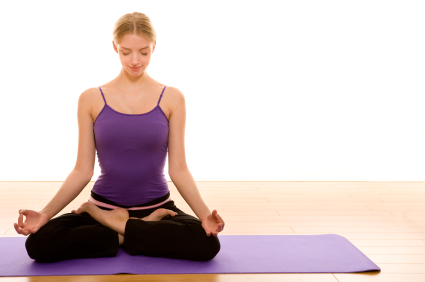 It serves as the perfect meditation timer. The researchers also found that when the default mode network (which consists of the medial prefrontal and posterior cingulate cortex) was active, brain regions associated with self-monitoring and cognitive control were also activated in experienced meditators, but not novices.
This suggests that skilled meditators constantly monitor and suppress the emergence of “me” thoughts and mind wandering. If they become too strong, these two states of mind are associated with diseases such as autism and schizophrenia.
The experienced meditators were able to co-activate the two brain regions both during meditation and while resting, which suggests they have developed a “new” default mode that’s more present-centered and less self-centered, the researchers said.
“Meditation’s ability to help people stay in the moment has been part of philosophical and contemplative practices for thousands of years,” Brewer said in a Yale news release. “Conversely, the hallmark of many forms of mental illness is a preoccupation with one’s own thoughts, a condition meditation seems to affect. This gives us some nice cues as to the neural mechanisms of how it might be working clinically.”
The study appears Nov. 21 in the Proceedings of the National Academy of Sciences.
More information
The U.S. National Center for Complementary and Alternative Medicine has more about meditation.
— Robert Preidt
SOURCE: Yale University, news release, Nov. 18, 2011
Use our unique “Zen Clock” which functions as a Yoga & Meditation Timer. It features a long-resonating acoustic chime that brings your meditation or yoga session to a gradual close, preserving the environment of stillness while also acting as an effective time signal. Our Yoga Timer & Clock can be programmed to chime at the end of the meditation or yoga session or periodically throughout the session as a kind of sonic yantra. The beauty and functionality of the Zen Clock/Timer makes it a meditation tool that can actually help you “make time” for meditation in your life. Bring yourself back to balance.
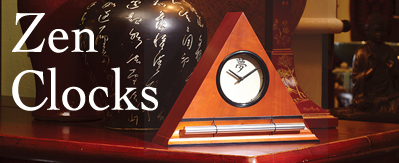 It's exquisite sounds summon your consciousness out of your meditative state with a series of subtle gongs. Once you experience the Zen Timepiece's progressive tones, you'll never want to meditate any other way. Now & Zen – The Meditation Timer Shop
1638 Pearl Street
Boulder, CO 80302
(800) 779-6383
orders@now-zen.com
Posted in Meditation Timers, Meditation Tools
 It's exquisite sounds summon your consciousness out of your meditative state with a series of subtle gongs. Once you experience the Zen Timepiece's progressive tones, you'll never want to meditate any other way. It serves as the perfect meditation timer. Set aside 30 minutes, preferably at the end of the day, to try this Naikan practice.
Sitting comfortably, with eyes closed, take a few moments to bring attention to your breath, mantra, or any other technique that you normally use to center yourself. When you feel settled, ask yourself this series of questions:
What have I received today?
Be specific and reflect on as many things as you can recall. It can be something as simple as your partner’s smile, the sound of a bird singing at dawn, the driver who let you merge into the crowded freeway. Remember, the motivation or attitude of those who gave you something is not the issue. Maybe you were offered lunch because you showed up at lunchtime, not because your friend made a personal effort to make you lunch. The fact is, you were fed, and you can feel gratitude for that. The mere fact that you benefited from someone’s actions is all that is needed to cultivate gratitude.
Notice which of these things you did not appreciate as they happened. Can you recall what was taking your attention when one of these acts of grace occurred? Were you stuck in problem-solving mode, thinking of your to-do list, or making judgments?
We often live as if the world owes us. As you reflect on what you have been given today, you will likely see that, if anything, you owe the world an insurmountable debt. This insight is more than merely humbling; you may find yourself feeling a deeper sense of gratitude and a natural desire to be generous in serving others.
What have I given today?
 This unique "Zen Clock" features a long-resonating acoustic chime that brings the meditation session to a gradual close, preserving the environment of stillness while also acting as an effective time signal. Go through the day’s events in the same way, but this time notice what you have given to others. Be as specific and concrete as possible. As above, your motivation is irrelevant. What did you actually do? It may have been as simple as feeding your cats, washing the breakfast dishes, or sending a friend a birthday card. You may find that without great fanfare you contribute to the well-being of many people and animals—you make a positive difference to the planet.
What difficulties and troubles did I cause today?
Again, be specific. Don’t overlook the seemingly insignificant. Your list may include things like “I backed up traffic while looking for a place to park” or “I chased the cats off the lounge chair so I could sit there.” This question is often the hardest, but its importance cannot be overstated. It may bring up feelings of remorse, but its primary purpose is to provide a more realistic view of your life.
 Now & Zen’s mission is to participate in the emerging movement in society toward a more spiritually focused lifestyle. In general, we are all too aware of how others cause us inconvenience or difficulty, but rarely do we notice when we are the source of inconvenience. And if we do, we usually brush it aside as an accident, not that big a deal, or simply something we didn’t mean to do. We cut ourselves a huge length of slack! But seeing how you cause others difficulty can deflate your ego while reminding you again of the grace by which you live.
These questions provide the framework for reflecting on all your relationships, including those with family, friends, co-workers, partners, pets, and even objects. You can reflect on the events of one day, a specific person over the course of your relationship, or a holiday visit with family.
Remember, what makes this a meditative practice is that you are not analyzing your motivations or intentions; you are not interpreting or judging. You are simply shifting your attention from self-centered thinking to seeing things as they are, and as all yoga traditions point out, in seeing, there is wisdom and liberation.
adapted from Yogajournal.com by By Frank Jude Boccio
Although meditation can be done in almost any context, practitioners usually employ a quiet, tranquil space, a meditation cushion or bench, and some kind of timing device to time the meditation session. Ideally, the more these accoutrements can be integrated the better. Thus, it is conducive to a satisfying meditation practice to have a timer or clock that is tranquil and beautiful. Using a kitchen timer or beeper watch is less than ideal. And it was with these considerations in mind that we designed our digital Zen Alarm Clock and practice timer. This unique “Zen Clock” features a long-resonating acoustic chime that brings the meditation session to a gradual close, preserving the environment of stillness while also acting as an effective time signal. The Digital Zen Clock can be programmed to chime at the end of the meditation session or periodically throughout the session as a kind of sonic yantra. The beauty and functionality of the Zen Clock/Timer makes it a meditation tool that can actually help you “make time” for meditation in your life.
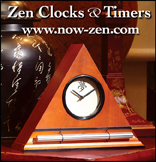 Now & Zen’s mission is to participate in the emerging movement in society toward a more spiritually focused lifestyle.
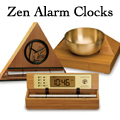 Rather than an artificial recorded sound played through a speaker, the Zen Clock features an alloy chime bar similar to a wind chime. Now & Zen – The Meditation Timer Shop
1638 Pearl Street
Boulder, CO 80302
(800) 779-6383
Orders@now-zen.com
Posted in intention, Meditation Timers, Meditation Tools, mindfulness practice
 It's exquisite sounds summon your consciousness out of your meditative state with a series of subtle gongs. Once you experience the Zen Timepiece's progressive tones, you'll never want to meditate any other way. It serves as the perfect meditation timer. Think meditating requires the patience, dedication, and endless free time of a Tibetan monk? Here are three simple ways to work this mind-calming, heart-strengthening discipline into your daily routine, no matter how confirmed a type A you are.
Walking Meditation Focus on your breathing; count your steps. Become aware of how your feet and legs move. Celebrate each movement as a miracle of silent communication between your brain and your body.
Mindfulness Concentrate all your energy on whatever you’re doing now, even something as mundane as washing dishes. Consider each element of the activity as if you were moving in slow motion. If other thoughts interrupt, gently bring your mind back to your task.
Mantra In Sanskrit, man means mind and tra means deliverance. Repeating a mantra–a word, phrase, or sound–creates a sound vibration that could deliver you from worldly cares. Choose a prayer, word, or sound that invokes a spiritual feeling. Sit comfortably and breathe deeply as you chant it silently.
adapted from Prevention by By Sara Altshul
Although meditation can be done in almost any context, practitioners usually employ a quiet, tranquil space, a meditation cushion or bench, and some kind of timing device to time the meditation session. Ideally, the more these accoutrements can be integrated the better. Thus, it is conducive to a satisfying meditation practice to have a timer or clock that is tranquil and beautiful. Using a kitchen timer or beeper watch is less than ideal.
And it was with these considerations in mind that we designed our digital Zen Alarm Clock and practice timer. This unique “Zen Clock” features a long-resonating acoustic chime that brings the meditation session to a gradual close, preserving the environment of stillness while also acting as an effective time signal. The Digital Zen Clock can be programmed to chime at the end of the meditation session or periodically throughout the session as a kind of sonic yantra. The beauty and functionality of the Zen Clock/Timer makes it a meditation tool that can actually help you “make time” for meditation in your life.
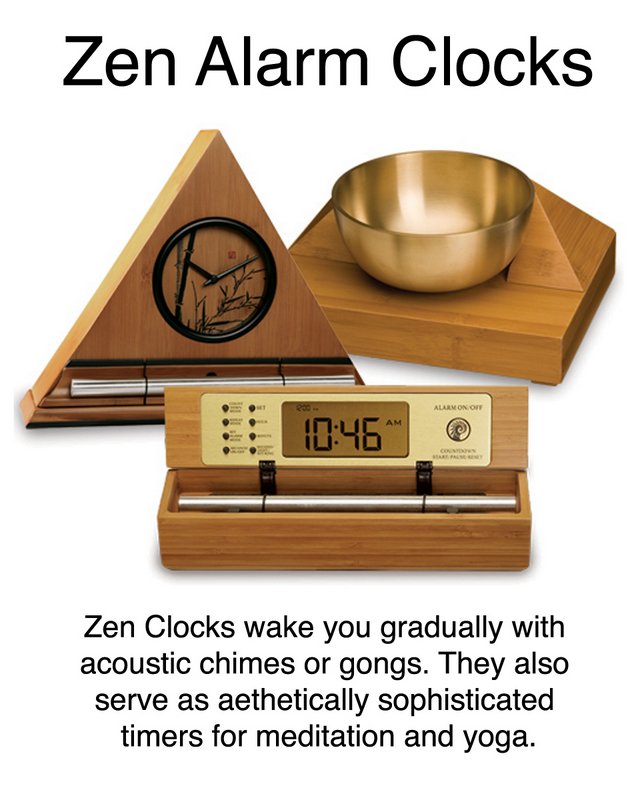 This unique "Zen Clock" features a long-resonating acoustic chime that brings the meditation session to a gradual close, preserving the environment of stillness while also acting as an effective time signal.
Posted in Bamboo Chime Clocks, Meditation Timers, Meditation Tools, mindfulness practice
 It's exquisite sounds summon your consciousness out of your meditative state with a series of subtle gongs. Once you experience the Zen Timepiece's progressive tones, you'll never want to meditate any other way. It serves as the perfect meditation timer. Available in 5 wood styles, including bamboo. Meditation as medication.
A federally funded study on hypertension conducted in West Oakland yielded positive results for the practitioners of transcendental meditation, a technique used to relax the body and the mind — and much, much more, say hardcore adherents.
Findings of the study were published Friday in the American Journal of Hypertension, a publication of the American Society of Hypertension Inc. The study was the work of a medical team led by Dr. Frank Staggers, a longtime Oakland physician who now works as a senior detox physician at the Haight Ashbury Free Clinic in San Francisco. Research for the project was conducted over a period of 10 years, starting in 1994.
The study comprised 150 people, whose average age was 49, who were divided into three separate groups and used separate techniques to try to reduce stress levels and lower blood pressure. One group practiced meditation, another used progressive muscle relaxation, and the third used conventional health and education techniques to lower blood pressure.
“I was working at the West Oakland Health Center in the 1980s when I made my first observations during the course of my patient examinations,” Staggers said. “I told my patients with hypertension to close their eyes, relax and take deep breaths.”
When Staggers began to notice a difference in the stress levels of his patients, he started digging a little deeper into relaxation techniques.
He contacted Dr. Robert Schneider, a colleague from Maharishi International University in Fairfield, Iowa, and the two put together a research team and sent a funding proposal to the National Institutes of Health. The NIH responded with a grant from its national Center for Complementary and Alternative Medicine.
Blood pressure, which is disproportionately high among African Americans, was monitored for a year in all three testing categories, Staggers said.
Transcendental meditation was chosen over other practices, such as Zen and religious meditation, because there were varying techniques and not nearly as much research data as had been collected on TM over the years.
 It features a long-resonating acoustic chime that brings your meditation or yoga session to a gradual close, preserving the environment of stillness while also acting as an effective time signal. “These techniques had a long track record and had been studied at some of the largest research universities in the nation, but they had never been studied with respect to treating disease,” Staggers said.
“As a practicing physician, I didn’t want to take a technique that no one has ever used, because you don’t know what will happen. TM has been studied since the 1960s.”
Of the three groups that participated in the study, meditation practitioners witnessed the reduction of 6 millimeters in diastolic pressure and a 3-millimeter drop in systolic blood-pressure readings.
There was also a 23 percent reduction in that group in the use of antihypertensive medications used to treat the disease.
Staggers said meditation has shown promise in helping reduce the symptoms of numerous physical and mental ailments, including asthma, depression, anxiety, cancer, diabetes and arthritis. He also said the technique can be an effective tool in the fight against drug dependency and addiction.
Joyce Muse-Harris, a nurse practitioner and Oakland resident who suffers from hypertension, took part it the study and heaps praise on how meditating for 20 minutes twice a day affects her health and outlook.
“I wanted to be in the meditation program because I’ve always believed in alternative medical techniques and haven’t always agreed with the techniques used in Western medicine,” she said.
The meditation sessions helped her reduce stress and “get a handle on some of the things that were happening in my life,” she said.
Muse-Harris used the techniques to deal with a colleague with whom she had a conflict. “After doing the meditation for a while, that person didn’t bother me anymore, because I decided I would not add to their stress,” she said.
Muse-Harris has gotten better at the technique and says she can now meditate just about anywhere — riding in a car or even on a BART train.
“At first it was difficult to do, but if you sit quietly, and let your mind relax, it will start running through all the errands you have to do, a shopping list, but if you don’t fight, those things fade away and your mind becomes clear,” she said.
Muse-Harris still takes hypertension medication but says the meditation provides her with an inner calm that keeps a lid on stressful reaction to challenging situations.
I must admit to a little skepticism about some the claims made by TMers over the years, particularly their description of mental-flying when a person achieves the highest state of the art.
The “yogic fliers” who sit in the lotus position and begin to hop around on foam cushions once they’ve reached a higher mental state always looked pretty suspicious to me, but this is a bit different.
If calming the mind in order to heal the body can be achieved through meditation instead of medication, I say go for it.
adapted from Sfgate.com by Chip Johnson
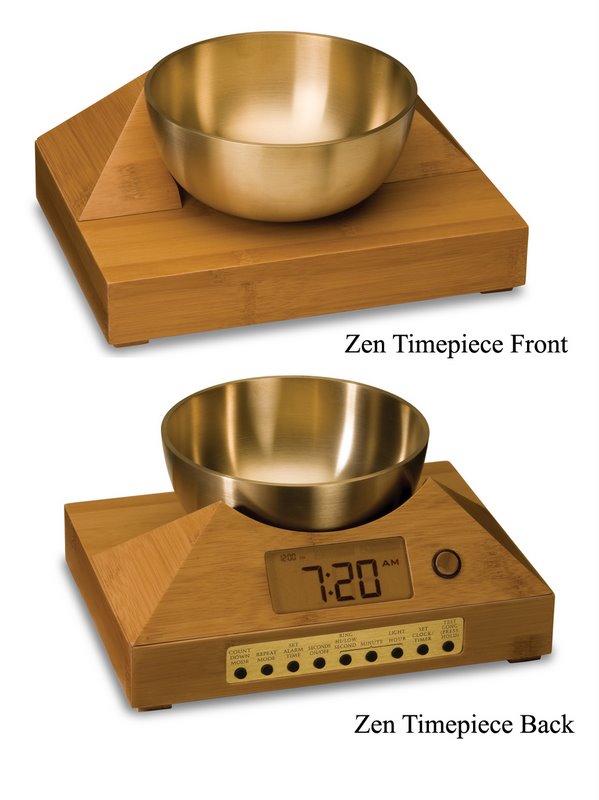 It features a long-resonating acoustic chime that brings your meditation or yoga session to a gradual close, preserving the environment of stillness while also acting as an effective time signal. Now & Zen – The Singing Bowl Meditation Timer Store
1638 Pearl Street
Boulder, CO 80302
(800) 779-6383
orders@now-zen.com
Posted in Bamboo Chime Clocks, Meditation Timers, Meditation Tools, mindfulness practice
« Previous Page — « Previous Entries
Next Entries » — Next Page »
|
|
|
|